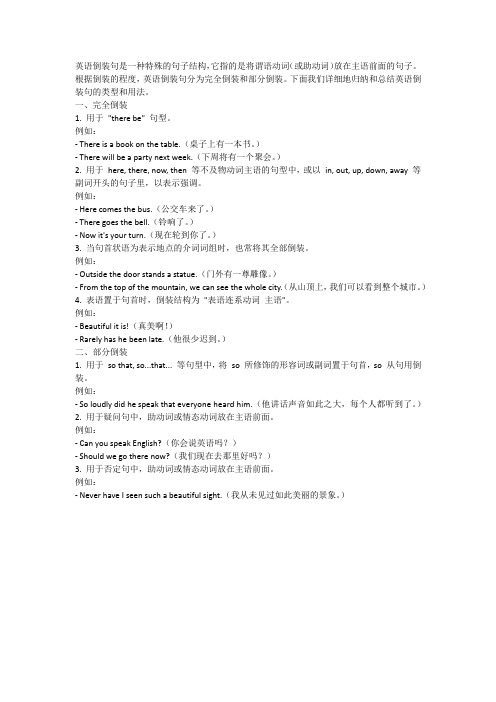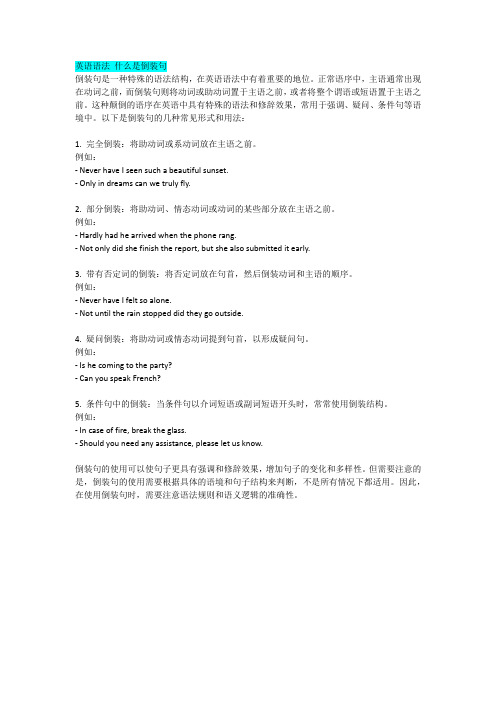英语倒装句的用法
- 格式:doc
- 大小:107.50 KB
- 文档页数:28

倒装句的作用倒装句是英语语法中的一种句子结构,在倒装句中,谓语动词和主语的顺序颠倒。
倒装句可以用于肯定句、否定句、疑问句以及特殊情况下的特殊句型。
倒装句有着多种作用和功能,以下是其中一些常见的作用和用法。
1.强调句首成分倒装句可以通过将句子的主语、状语或其他成分置于句首来实现强调的效果。
例如:- "Not only did she finish the project on time, but she also exceeded our expectations."(她不仅按时完成了项目,还超出了我们的预期。
)- "Here comes the bus!"(车来了!)在这些例子中,倒装句用于强调句子中的某个成分,使其更加突出。
2.表示条件在表示条件的句子中,一般会采用倒装结构,将条件状语从句的谓语动词提前。
例如:- "Should you have any questions, feel free to ask."(如果你有任何问题,请随时问。
)- "Had he worked harder, he would have passed the exam."(如果他努力学习,他就能通过考试。
)这种倒装句结构可以使条件更加突出和强调。
3.疑问句在一般疑问句中,动词通常要倒装到主语的前面。
例如:- "Do you like to travel?"(你喜欢旅行吗?)- "Have you finished your homework?"(你完成作业了吗?)倒装句的疑问形式使得问题更加明确,语气更加直接。
4.特殊句型倒装句也用于特殊句型中,例如:- “So +助动词/情态动词+主语”:"So did I."(我也是。
)- “Neither/nor +助动词/情态动词+主语”:"Neither do I."(我也不。

英语倒装句是一种特殊的句子结构,它指的是将谓语动词(或助动词)放在主语前面的句子。
根据倒装的程度,英语倒装句分为完全倒装和部分倒装。
下面我们详细地归纳和总结英语倒装句的类型和用法。
一、完全倒装1. 用于"there be" 句型。
例如:- There is a book on the table.(桌子上有一本书。
)- There will be a party next week.(下周将有一个聚会。
)2. 用于here, there, now, then 等不及物动词主语的句型中,或以in, out, up, down, away 等副词开头的句子里,以表示强调。
例如:- Here comes the bus.(公交车来了。
)- There goes the bell.(铃响了。
)- Now it's your turn.(现在轮到你了。
)3. 当句首状语为表示地点的介词词组时,也常将其全部倒装。
例如:- Outside the door stands a statue.(门外有一尊雕像。
)- From the top of the mountain, we can see the whole city.(从山顶上,我们可以看到整个城市。
)4. 表语置于句首时,倒装结构为"表语连系动词主语"。
例如:- Beautiful it is!(真美啊!)- Rarely has he been late.(他很少迟到。
)二、部分倒装1. 用于so that, so...that... 等句型中,将so 所修饰的形容词或副词置于句首,so 从句用倒装。
例如:- So loudly did he speak that everyone heard him.(他讲话声音如此之大,每个人都听到了。
)2. 用于疑问句中,助动词或情态动词放在主语前面。
例如:- Can you speak English?(你会说英语吗?)- Should we go there now?(我们现在去那里好吗?)3. 用于否定句中,助动词或情态动词放在主语前面。

英语倒装句语法总结英语倒装句是一种句法结构,它通过将主语和助动词的位置颠倒,以实现强调、表示条件或修饰的功能。
倒装句在英语中常常用于口语和书面语中,给文本增加了一定的变化和兴趣。
在本文中,将对英语倒装句进行详细总结,以便读者更好地理解和运用这一语法结构。
一、完全倒装句在完全倒装句中,整个谓语动词位于主语之前,这种倒装句一般用于以下几种情况:1. 当以“here”、“there”、“now”或表示地点、时间的副词开头的句子时,倒装句常被使用。
例如:Here comes the bus.There goes John.Now is the time for action.2. 在以表示否定意义的副词或短语开头的句子中,倒装句也常见。
例如:Never have I seen such a beautiful sunset.Not only is she talented, but she is also kind-hearted.3. 在以“only”开头修饰状语从句的句子中,倒装句也经常使用。
例如:Only when you face your fears can you overcome them.Only in this way can the problem be solved.二、部分倒装句部分倒装句中,只将助动词或情态动词放在主语之前,而将主语与谓语动词的位置维持原状。
部分倒装句常用于以下几种情况:1. 当以否定副词“never”、“seldom”或“rarely”开头时,部分倒装句可以被采用。
例如:Never have I been so happy.Seldom does he complain about anything.2. 在以“so”或“such”引导的句子中,为了表达强调,可以使用部分倒装句。
例如:So tired was she that she fell asleep on the couch.Such is the power of love that it can conquer all obstacles.3. 在以“not”开头的句子中,为了增强否定的语气,常常使用部分倒装句。

英语里倒装句的用法英语倒装句的用法英语倒装句是英语中很重要的一种句型,难度相对也有点大。
你掌握了吗。
接下来小编在这里给大家带来英语倒装句的用法,我们一起来看看吧!英语倒装句的用法英语中常见的倒装:1. 在疑问句中。
Did you had your hair cut yesterday?2. 在there be 结构中。
There are several students in the classroom.3. 直接引语的一部分或全部放在句首时,有时也用倒装。
“ Build up your self-confidence.” said the teacher.4. 在表示方向,地点的副词或某些介词词组开头的里,如there, here, out, in, up, down, away, in front of等,以示强调。
On the top of the hill stands an old temple.Away flew the bird.Out rushed the pupils.但主语是人称代词时,主语和谓语的语序不变。
Here it is.Away he went.5. 含有否定意义的副词或连词,如never, not, not only, little, seldom, hardly等,放在句首时。
Not only am l out-going and active, but also enthusiastic and optimistic.Never will he forget the first day to go to school.Hardly had I got out of the house when it began to rain.基本语序6. Only 所修饰的副词,介词短语或状语从句放在句首时。
Only in this way can you have a good command of a foreignlanguage.Only if you put your mind into something can you get the best result of it.7. So , neither, nor引起的句子,表示前面的情况也适用于另一个人或事物时。

英语语法什么是倒装句倒装句是一种特殊的语法结构,在英语语法中有着重要的地位。
正常语序中,主语通常出现在动词之前,而倒装句则将动词或助动词置于主语之前,或者将整个谓语或短语置于主语之前。
这种颠倒的语序在英语中具有特殊的语法和修辞效果,常用于强调、疑问、条件句等语境中。
以下是倒装句的几种常见形式和用法:1. 完全倒装:将助动词或系动词放在主语之前。
例如:- Never have I seen such a beautiful sunset.- Only in dreams can we truly fly.2. 部分倒装:将助动词、情态动词或动词的某些部分放在主语之前。
例如:- Hardly had he arrived when the phone rang.- Not only did she finish the report, but she also submitted it early.3. 带有否定词的倒装:将否定词放在句首,然后倒装动词和主语的顺序。
例如:- Never have I felt so alone.- Not until the rain stopped did they go outside.4. 疑问倒装:将助动词或情态动词提到句首,以形成疑问句。
例如:- Is he coming to the party?- Can you speak French?5. 条件句中的倒装:当条件句以介词短语或副词短语开头时,常常使用倒装结构。
例如:- In case of fire, break the glass.- Should you need any assistance, please let us know.倒装句的使用可以使句子更具有强调和修辞效果,增加句子的变化和多样性。
但需要注意的是,倒装句的使用需要根据具体的语境和句子结构来判断,不是所有情况下都适用。
因此,在使用倒装句时,需要注意语法规则和语义逻辑的准确性。

英语倒装句用法经典总结英语倒装句是一种语法现象,用法广泛,能够提高句子的表达力和语言的鲜明度。
它常用于强调句子中的某个部分,或使句子结构更为紧凑。
下面是关于英语倒装句用法的经典总结。
一、完全倒装句1. 在句首出现的副词或短语:用于表示地点的副词(here, there)或表示方式的副词(in this way, in no case)等。
例:There goes the bus.Here comes the teacher.In no case should you tell him the secret.2. 情态动词、助动词或be动词在句首:在由情态动词(can, could, may, might, must, shall, should, will, would等)引导的疑问句或条件句中,情态动词需要放在句首。
例:Can you swim?Should you have any questions, please feel free to ask.3. 在虚拟条件句中:在虚拟条件句中,如果主语是名词,则将were放在句首。
例:Were I to win the lottery, I would buy a house.4. 否定词位于句首:如果句子中存在否定词,如never, seldom, not only...but also等,否定词需要放在句首。
例:Never have I seen such a beautiful sunset.Not only is he clever, but also hardworking.5. Only修饰副词、介词短语或状语从句时:当only修饰副词、介词短语或状语从句时,倒装现象会出现。
例:Only in this way can we solve the problem.Only when he arrived did she start to cook.6. 某些表示条件的介词短语:由in case, in the event that或on condition等表示条件的介词短语引导的句子中,介词短语需要放在句首。
倒装句的用法归纳
倒装句的用法主要包括完全倒装和部分倒装。
完全倒装是指将句子中的谓语动词全部置于主语之前,常见的结构有:
1. 当句首是表示地点、时间、方位的副词,如here、there、in、up、down、on、out、back、then、away、off、over等,而谓语动词是rush、run、come、go、fly等不及物动词时,用全部倒装结构,此时的谓语动词不需要助动词。
例如:Out rushed the children.
2. 表示地点的介词短语位于句首时。
例如:On the wall hang two large portraits.
3. 当such置于句首时。
例如:Such are the facts, no one can deny them. 其中such当作表语.
4. 直接引语的部分或全部位于句首时,点明说话人的部分主谓语要倒装。
例如:“What are you doing?”asked she .
5. 在某些表示祝愿的句子中。
例如:Long live our great country!伟大的祖国万岁!
部分倒装是指将谓语的一部分如助动词或情态倒装至主语之前。
如果句中的谓语没有助动词或情态动词,则需添加助动词do, does或did,并将其置于主语之前。
以上信息仅供参考,如有需要,建议查阅语法书籍或咨询英语教师。
英语倒装句的用法归纳一、倒装句的定义英语倒装句是一种语法结构,其中谓语动词的位置放在了主语之前。
这种语法现象在英语中比较常见,尤其是在某些句型和表达方式中。
二、倒装句的分类1.全倒装句:谓语动词完全放在主语之前,有时需要助动词的帮助,如be、have、can等。
2.部分倒装句:只有部分谓语动词放在主语之前,通常是助动词、情态动词或系动词。
三、倒装句的用法1.用于强调:在某些情况下,使用倒装句可以强调谓语动词或表达方式。
例如:Here comes the bus!(公交车来了!)强调“公交车”即将到来。
2.用于疑问句:在疑问句中,通常使用倒装句来重新排列句子结构。
例如:Do you like music?(你喜欢音乐吗?)3.用于条件状语从句:在条件状语从句中,可以使用倒装句来表示与主句的对比或强调。
例如:If only I were a millionaire!(如果我是个百万富翁就好了!)4.用于让步状语从句:在让步状语从句中,可以使用倒装句来表示转折关系。
例如:Try to find a way to solve the problem!(试着找到解决问题的方法!)5.用于虚拟语气:在虚拟语气中,可以使用倒装句来表示与实际情况相反的情况。
例如:If I were you,I would go to the party.(如果我是你,我会去参加派对。
)6.用于某些固定句型:有些固定句型要求使用倒装句。
例如:“Hardly had she sat down when the phone rang.”(她刚坐下电话就响了。
)7.表示惊讶、感叹、讽刺等情绪时也可以使用倒装句。
例如:How could you do such a thing!(你怎么能做出这种事!)四、倒装句的用法归纳总结1.英语倒装句是一种语法结构,主要有全倒装句和部分倒装句两种类型。
2.使用倒装句可以强调谓语动词或表达方式,也可以用于疑问句、条件状语从句、让步状语从句和虚拟语气等语法结构中。
高中英语知识点归纳倒装句的用法倒装句是英语中的一种常见语法现象,它与一般的语序有所不同。
在倒装句中,谓语动词不再位于句子的中间,而是移到主语之前或状语之前,这种语法结构的运用可以使句子显得更加生动有趣。
下面将对高中英语中常见的倒装句进行归纳总结。
一、完全倒装句完全倒装句是指将助动词、情态动词或系动词放在主语之前,句子的谓语动词则位于主语之后。
完全倒装句的结构为:助动词/情态动词/系动词+主语+谓语动词+其他。
1.助动词完全倒装句助动词包括be动词、have动词和do动词。
当句子以副词here、there或表示方向的副词(如up、down、in、out等)开头时,为了突出地点或方向,可以采用助动词完全倒装的形式。
例如:Here comes the bus.There is a cat under the table.Down came the rain.2.情态动词完全倒装句情态动词包括can、could、may、might、must、shall、should、will、would等。
在表示祝愿、建议、命令等意义时,可以采用完全倒装的形式。
例如:May you have a happy birthday!Should you need any help, feel free to ask.Will you please close the door?3.系动词完全倒装句系动词包括be动词、seem、appear、look、sound等。
在表示位置、方式、状态、主语特征等方面时,可以采用系动词完全倒装的形式。
例如:On the table lies a book.How beautiful the flowers are!Tired as he was, he kept working.二、部分倒装句部分倒装句是指将谓语动词的一部分(通常是助动词或情态动词)与主语之间的位置对调,这种语法结构常见于否定句、选择疑问句和以感叹词开头的句子。
英语倒装句用法经典总结1.完全倒装句:主语和谓语动词完全倒置。
如:- Never have I seen such a beautiful sunset.(我从未见过如此美丽的日落。
)- Little did he know about the problem.(他对问题一无所知。
)2.部分倒装句:只将助动词或情态动词和主语进行倒置。
如:- Can you swim?(你会游泳吗?)- Should you have any questions, please let me know.(如果你有任何问题,请告诉我。
)3.如果句子以表示地点的副词或介词短语开头,也需要进行倒装。
如:- On the top of the mountain stood a small cabin.(在山顶上有一间小木屋。
)4.如果句子以表示否定意义的副词或介词短语开头,也需要进行倒装。
如:- Under no circumstances will I allow that to happen.(无论如何,我都绝不容许那种事情发生。
5. 在条件句中,如果主语和谓语动词之间使用“had”,“were”或“should”时,需要进行倒装。
如:- Had I known it earlier, I would have prepared better.(要是早知道这个,我会准备得更好。
)- Were I you, I would apologize.(要是我是你,我会道歉。
)以上是英语倒装句的几种常见用法,不同的倒装句用法可以根据具体的语境和语法规则进行灵活运用。
英语倒装句的用法英语倒装句的用法英语句子按主谓排列顺序来分有正常语序和倒装语序。
正常语序的结构是“主语+谓语”,倒装语序为“谓语(或谓语的一部分)+主语”。
1)部分倒装---- 助动词\情态动词+主语+谓语的实义动词型2)全倒装---- 谓语+主语型在以下结构中用全倒装此结构通常只用与一般现在时和一般过去时。
常见的结构有:1.在there be或者There live(stand,appear.seem,remain,exist….) 句型中;如There are thousands of peopl e on the square. Thousands of peopl e are there on the square.There lived an ol d fisherman in the village. 原语序:An ol d fisherman lived there in the village.There stands a littl e girl. 正常语序:A littl2.在“here, there, now,thus, then+动词+主语”的句子中,(谓语动词为be, go, come, lie, run 等转移动词一起连用,主语为名词);如: Now comes my turn. There goes the bell. Then came the order to l eave.Here comes a bus= A bus comes here.A)此类倒装不用进行时态。
Here comes a taxi! There goes the last train! 有辆出租车来了! 最后一班火车开走了! (注意这里不可用进行时)B)上述全部倒装的句型结构的主语必须是名词,如果主语是人称代词则不能完全倒装。
Here it comes!There it goes!3.在“out\ in, up\ d own, off\away,in the distance,on the hill,round the corner”等表示方向性的副词或表示地点的介词词组位于句首,且主语又是名词,谓语是表示运动的动词。
Away went the crowed one by one. In came a stranger in black.Out rushed the chil dren.. Down fell the l eaves. On the fl oor were pil es of ol d books.☆注意:主语必须是名词eg: Out she went.There they are. Here he comes. 而Out went the girl. Here comes the boy.地点状语后面如有表示位置的动词(如lie, live, sit, stand) 或转移的动词(如come, go, rise),用作主语的名词可以放在动词之后。
这种情形主要出现在描写文中。
如:At the top of the hill stood the tiny chapel. 那座小教堂矗立在山顶上。
In the fields of poppies lay the dying soldiers. 罂粟地里躺着奄奄一息的士兵们。
别的动词如属被动语态也可以倒装。
In the distance could be seen the pu rple mountains. 远处可以见到紫色的山。
主语如是代词则不能倒装:At the top of the hill it stood out ag ainst the sky. 它背衬青天矗立在山顶上。
有时为了强调或者为了使句子平衡或者为了使上下文连接得更加紧密,就将表语和地点状语(多为介词短语)置于句首,谓语动词也常置于主语前,构成完全倒装。
如:By the door stood an armed guard.门口站着一名手持武器的士兵。
At the next t able was a pretty girl waiting for someon e. 隔壁桌上坐着一个等人的漂亮姑娘。
Among these people was his friend Ji m. 他的朋友吉姆就在这些人当中。
By the window sat a young man with a magazine in his hand. 窗户边坐着一个年轻人,手里拿着一本杂志。
At the front of the book is a table of contents, giving details of what is in the book. 书的前部有目录,详列了书中的内容。
*4.有时为了强调表语,构成“表语+连系动词+主语”结构;eg: Lucky is she who was chosen to be a l eader.=She who was chosen to be a leader is lucky.Gone are the days when women were l ooked down upon!The days when women were l ooked d own upon are gone!表语置于句首,且主语较长或结构较复杂的句子要用全部倒装。
如:Gone are the days when we had nothing to eat.直接引语的一部分或全部放在句首时,如果主语是名词, 有时也用倒装。
“Let’s go,” sa id the man*5、在某些表示愿望的感叹句,全倒装。
Long live the Peopl e's Republic of China!May you be happy.在以下结构中用部分倒装部分倒装是指将谓语的一部分如助动词或情态倒装至主语之前。
如果句中的谓语没有助动词或情态动词,则需添加助动词do, does或did,并将其置于主语之前。
1. 用于疑问句中。
如:1) How are you doing﹖2) Did you see the film yesterday﹖2.含有否定或半否定意义的词语(如:not,never,sel dom,hardly,littl e,scarcely,barely,f ew…);或者含有否定意义的连词(not only…but also.., neither..nor.., no sooner had…than...(一。
就。
),scarely..than.., Hardly had when.., not until...;nowher等);或否定意义的介词词组(by no means(决不),in no case\way (任何情况下都不),with no method, at no time(决不), on no account(决不),under no circumstances\condition...(任何情况下都不))位于句首eg: I have never seen him before.=Never have I seen him before.Not a word did he say when he l eft. Sel dom/Scarecely does he go to that park. Hardly(几乎不。
) do I speak to him. Littl e English can he speak.Littl e does he realize the importance of the meeting. Few peopl e did I see in the street. 含有否定意义的连词:eg:1)Not only can he play basketball, but also I can. 2)No sooner had we arrived home than it began to rain. 3)Hardly had we met our friends when the train l eft.4)Not until the baby fell asl eep did the mother leave the room.(主句倒装,从句不倒装)=The mother didn’t l eave the room until the baby fell asl eep.注意:1)Not only...but also...必须连接两个分句时,才使用部分倒装。
而且只倒装not o nly后的分句。
如果连接的是两个并列词语,不用倒装结构。
如:Not only his father but al so I like reading. not only…but also…前后连接两个句子时,not only后的句子要用部分倒装,但but also后的分句不用倒装。
如:Not only did he come, but he saw he r. 他不仅来了,而且还见到了她。
Not only is he a teacher, but he is al so a poet. 他不仅是一位教师,而且是一位诗人。
Not only did he speak more correctly, but he spoke more easily. 不仅他讲得更正确,也讲得更不费劲了。
Not only did they present a musical performance, but they also gave a brief i ntroduction to the history of Western bra ss instruments. 他们不但做了音乐表演,而且简短地介绍了西方铜管乐器的历史。
2)Hardly...when..., Scarcely...than..., No sooner...than...意义基本相同,它们连接的句子,都只倒装前一个分句,及“前倒后不倒(装)”。
3)当not until(直到。
才)引导主从复合句时,主句倒装,从句不用倒装,或者可以理解为“后倒前不倒(装)”。
1. Not only ___, but he himself was badly beaten up.A. was he robbed everything he hadB. everything he had was robbed ofC. had everything he had been robbed ofD. was he robbed of everything he had2. I finally was admitted to Beijing University. Never in all my life ___ so happy.A. I feltB. did I feelC. I had feltD. had I felt3. No sooner ___ to sl eep than the tel ephone rang once more.A. she wentB. she had goneC. didshe go D. had she gone4. Hardly ___ to write the composition when the bell ___.A. had I begun; rangB. I wasbeginning; rangC. had I begun; was ringingD. I willbegin; rings5. Not until the early years of the 19th century ___ what heat is.A. man did knowB. manknowC. didn't man knowD. did manknow含有否定意义的介词词组:如:By no means shoul d we tell lies. On no account shoul d we l et him leave.At no time决不will I get married to you. In [Under] no circumstances will I l end money to him.注意:in no time(立即,马上)位于句首时,其后无需用倒装语序:In no time he worked out the probl em. 他马上就算出了那道题。